
The Villa Giustinian, Ciani Bassetti, known as Castello di Roncade, is a Venetian villa in Roncade, near Treviso. The villa is surrounded by turreted walls in imitation of a medieval fortress, with the villa within.

The Villa Giustinian, Ciani Bassetti, known as Castello di Roncade, is a Venetian villa in Roncade, near Treviso. The villa is surrounded by turreted walls in imitation of a medieval fortress, with the villa within.
The property belonged to the Badoer family in the 15th century, who owned several mills in Musestre. In 1495 Girolamo Badoer left the estate to his daughter Agnesina, who married Benedetto Badoer. Widowed, Agnesina married Girolamo Giustinian. Agnesina and her second husband built a villa, which was underway in 1514, and completed by 1529. The villa remained in the Giustinian familyuntil 1915, when it was purchased by the Ciani Bassetti family. [1]
During World War II the fortified villa was used as a German command post, and was a target for aerial bombardment which damaged the walls and turrets. [1]

The rectangular complex is surrounded by moated walls. The villa stands within, flanked by extensions that served an agricultural purpose. The western wall features the main entrance, flanked by prominent turrets. [1] [2]
In contrast to the fortress-like exterior, the villa is a simple rectangular block with a two-story pedimented arcade on slender columns. The side bays are two and a half stories high, with arched windows in the first and second levels, and small square windows in the attic story, with a hipped roof. The prominent chimneys are proportioned and detailed to echo the entrance turrets. [1]
The interior is organized around a center hall on the two main levels. Interior ceilings are of beamed wood construction. [1]

Andrea Palladio was an Italian Renaissance architect active in the Venetian Republic. Palladio, influenced by Roman and Greek architecture, primarily Vitruvius, is widely considered to be one of the most influential individuals in the history of architecture. While he designed churches and palaces, he was best known for country houses and villas. His teachings, summarized in the architectural treatise, The Four Books of Architecture, gained him wide recognition.
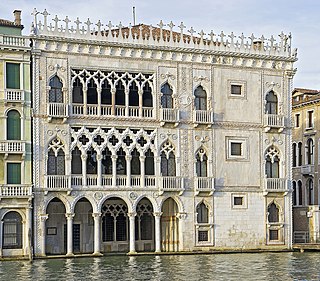
The Ca' d'Oro, or Palazzo Santa Sofia, is a palace on the Grand Canal in Venice, northern Italy. Ca' d'Oro or Cadoro translates to "House of Gold" or "Golden House" in English because of the gilt and polychrome external decorations that once adorned its walls. It was designed by Marino Contarini and later restored by Baron Giorgio Franchetti. In 1927, the building was converted into a museum and since then has been known as the Galleria Giorgio Franchetti alla Ca' d'Oro.

The Villa Farnese, also known as Villa Caprarola, is a pentagonal mansion in the town of Caprarola in the province of Viterbo, Northern Lazio, Italy, approximately 50 kilometres (31 mi) north-west of Rome, originally commissioned and owned by the House of Farnese. A property of the Republic of Italy, Villa Farnese is run by the Polo Museale del Lazio. This villa is not to be confused with two similarly-named properties of the family, the Palazzo Farnese and the Villa Farnesina, both in Rome.

Ca' Foscari, the palace of the Foscari family, is a Gothic building on the waterfront of the Grand Canal in the Dorsoduro sestiere of Venice, Italy.

Ca' Rezzonico is a palazzo and art museum on the Grand Canal in the Dorsoduro sestiere of Venice, Italy. It is a particularly notable example of the 18th century Venetian baroque and rococo architecture and interior decoration, and displays paintings by the leading Venetian painters of the period, including Francesco Guardi and Giambattista Tiepolo. It is a public museum dedicated to 18th-century Venice and one of the 11 venues managed by the Fondazione Musei Civici di Venezia.

Villa Emo is one of the many creations conceived by Italian Renaissance architect Andrea Palladio. It is a patrician villa located in the Veneto region of northern Italy, near the village of Fanzolo di Vedelago, in the Province of Treviso. The patron of this villa was Leonardo Emo and remained in the hands of the Emo family until it was sold in 2004. Since 1996, it has been conserved as part of the UNESCO World Heritage Site "City of Vicenza and the Palladian Villas of the Veneto".
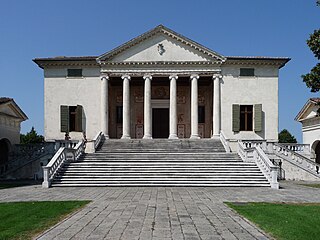
Villa Badoer is a villa in Fratta Polesine, in the Veneto region of northern Italy. It was designed in 1556 by Italian Renaissance architect Andrea Palladio for the Venetian noble Francesco Badoer, and built between 1557 and 1563 on the site of a medieval castle, which guarded a bridge across a navigable canal. This was the first time Palladio used his fully developed temple pediment in the façade of a villa.
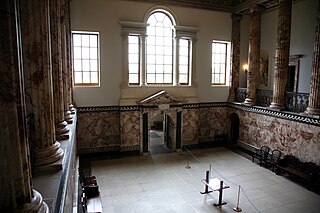
A Venetian window is a large tripartite window which is a key element in Palladian architecture. Although Sebastiano Serlio (1475–1554) did not invent it, the window features largely in the work of the Italian architect Andrea Palladio (1508–1580) and is almost a trademark of his early career. The true Palladian window is an elaborated version. Both the Venetian window or Serlian window and the Palladian window were inspired by Hellenistic and Roman examples which are part of the classical tradition and related to prestige and sacredness.

Palmanova is a town and comune (municipality) in the Regional decentralization entity of Udine in Friuli-Venezia Giulia, northeast Italy. The town is an example of a star fort of the late Renaissance, built up by the Venetian Republic in 1593.

The Palladian villas of the Veneto are villas designed by Renaissance architect Andrea Palladio, all of whose buildings were erected in the Veneto, the mainland region of north-eastern Italy then under the political control of the Venetian Republic. Most villas are listed by UNESCO as part of a World Heritage Site named City of Vicenza and the Palladian Villas of the Veneto.
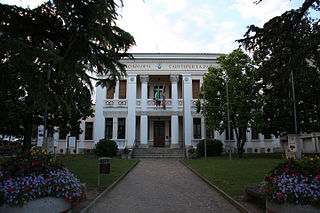
Cornuda is a comune with 6,276 inhabitants in the province of Treviso.

San Francesco della Vigna is a Roman Catholic church in the Sestiere of Castello in Venice, northern Italy.

Villa Duodo, also known as the Villa Valier, is a villa situated at Monselice near Padua in the Veneto, northern Italy. It is attributed to the architect Vincenzo Scamozzi although some later parts are known to have been designed by Andrea Tirali. The villa was built for a Venetian patrician, Francesco Duodo, circa 1592.

The Koules or Castello a Mare is a fortress located at the entrance of the old port of Heraklion, Crete, Greece. It was built by the Republic of Venice in the early 16th century, and is still in good condition today.

Tvrdalj Castle is a castle in Stari Grad, on the island of Hvar, Croatia.

Verrès Castle is a fortified 14th-century castle in Verrès, in the lower Aosta Valley, in north-western Italy. It has been called one of the most impressive buildings from the Middle Ages in the area. Built as a military fortress by Yblet de Challant in the fourteenth century, it was one of the first examples of a castle constructed as a single structure rather than as a series of buildings enclosed in a circuit wall.
The castle stands on a rocky promontory on the opposite side of the Dora Baltea from Issogne Castle. The castle dominates the town of Verrès and the access to the Val d'Ayas. From the outside it looks like an austere cube, thirty metres long on each side and practically free of decorative elements.

The Basilica di San Pietro di Castello, commonly called San Pietro di Castello, is a Roman Catholic minor basilica of the Patriarch of Venice located in the Castello sestiere of the Italian city of Venice. The present building dates from the 16th century, but a church has stood on the site since at least the 7th century. From 1451 to 1807, it was the city's cathedral church, though hardly playing the usual dominant role of a cathedral, as it was overshadowed by the "state church" of San Marco and inconveniently located. During its history, the church has undergone a number of alterations and additions by some of Venice's most prominent architects. Andrea Palladio received his first commission in the city of Venice from the Patriarch Vincenzo Diedo to rebuild the facade and interior of St Pietro, but Diedo's death delayed the project.
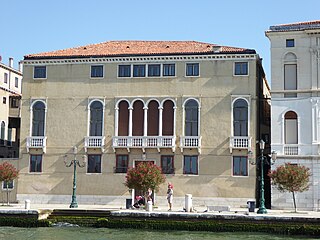
Palazzo Giustinian Recanati is a palace in Venice, Italy, located in the Dorsoduro district and overlooking the Giudecca Canal, just to the left of Palazzo Clary.

The Venetian patriciate was one of the three social bodies into which the society of the Republic of Venice was divided, together with citizens and foreigners. Patrizio was the noble title of the members of the aristocracy ruling the city of Venice and the Republic. The title was abbreviated, in front of the name, by the initials N.H., together with the feminine variant N.D.. Holding the title of a Venetian patrician was a great honour and many European kings and princes, as well as foreign noble families, are known to have asked for and obtained the prestigious title.

The Agazzano Castle is a fortification located in Agazzano, in the province of Piacenza. The castle is located on the edge of Agazzano town, not far from the main square, which was intended to be defended by the castle, and it is located in the heart of the Luretta Valley, a short distance from the course of the Luretta creek, at a point of slight elevation difference, where the last hill extensions of the Ligurian Apennines give way to the Po Valley.